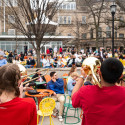Weedy tree removal clears way for new gardens
When you visit the UW Arboretum this spring, expect to see some dramatic changes in the land surrounding the visitor center-including the removal of dozens of black locust trees.
As part of its master plan for capital improvements, the Arboretum is removing a stand of black locusts in an area that will become part of a new collection of native Wisconsin plants.
This four-acre garden will showcase the beauty and variety of our state’s native species for students, home gardeners, professional landscapers, and visitors preparing to explore the Arboretum’s prairies, woodlands, and wetlands.
A demonstration garden will provide information and ideas for people who wish to use native plants in their home landscapes, and a children’s adventure garden will invite exploration and discovery for young visitors. Also, a labeled specimen garden will help students learn to identify plants.
Black locust is a problem species in many of Wisconsin’s conservation lands, including the Arboretum. Early settlers imported the trees, which are native to Missouri, Arkansas, and the Appalachian region, for use as fence posts.
Black locusts (Robinia pseudoacacia) reproduce aggressively, dispersing numerous viable seeds and sending out root suckers. Left to their own devices, this and other weedy species can crowd out critical native trees, destroy the undergrowth, and damage the soil. In turn, the presence of these unwelcome trees can destroy wildlife habitat.
For information about supporting the Arboretum’s native Wisconsin garden, please call Donna Thomas, (608) 265-2538.



